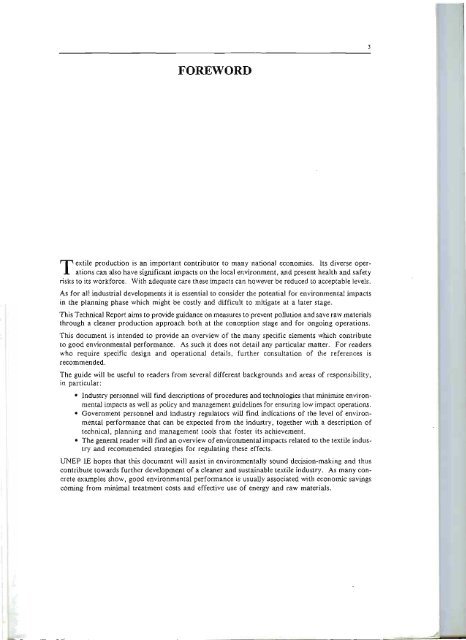Contributor, The Textile Industry and the Environment, UNEP
Contributor, The Textile Industry and the Environment, UNEP
Contributor, The Textile Industry and the Environment, UNEP
You also want an ePaper? Increase the reach of your titles
YUMPU automatically turns print PDFs into web optimized ePapers that Google loves.
T<br />
FOREWORD<br />
extile production is an important contributor to many national economies. Its diverse operations<br />
can also have significant impacts on <strong>the</strong> local environment, <strong>and</strong> present health <strong>and</strong> safety<br />
risks to its workforce. With adequate care <strong>the</strong>se impacts can however be reduced to acceptable levels.<br />
As for all industrial developments it is essential to consider <strong>the</strong> potential for environmental impacts<br />
in <strong>the</strong> planning phase which might be costly <strong>and</strong> difficult to mitigate at a later stage.<br />
This Technical Report aims to provide guidance on measures to prevent pollution <strong>and</strong> save raw materials<br />
through a cleaner production approach both at <strong>the</strong> conception stage <strong>and</strong> for ongoing operations.<br />
This document is intended to provide an overview of <strong>the</strong> many specific elements which contribute<br />
to good environmental performance. As such it does not detail any particular matter. For readers<br />
who require specific design <strong>and</strong> operational details. fur<strong>the</strong>r consultation of <strong>the</strong> references is<br />
recommended.<br />
<strong>The</strong> guide will be useful to readers from several different backgrounds <strong>and</strong> areas of responsibility,<br />
in particular:<br />
• <strong>Industry</strong> personnel will find descriptions of procedures <strong>and</strong> technologies that minimise environmental<br />
impacts as well as policy <strong>and</strong> management guidelines for ensuring low impact operations.<br />
• Government personnel <strong>and</strong> industry regulators will find indications of <strong>the</strong> level of environmental<br />
performance that can be expected from <strong>the</strong> industry, toge<strong>the</strong>r with a description of<br />
technical, planning <strong>and</strong> management tools that foster its achievement.<br />
• <strong>The</strong> general reader will find an overview ofenvuorunentaJ impacts related to <strong>the</strong> textile industry<br />
<strong>and</strong> recommended strategies for regulating <strong>the</strong>se effects.<br />
<strong>UNEP</strong> IE hopes that this document will assist in environmentally sound decision-making <strong>and</strong> thus<br />
contribute towards fur<strong>the</strong>r development of a cleaner <strong>and</strong> sustainable textile industry. As many concrete<br />
examples show, good environmental performance is usually associated with economic savings<br />
coming from minimal treatment costs <strong>and</strong> effective use of energy <strong>and</strong> raw materials.<br />
3

















